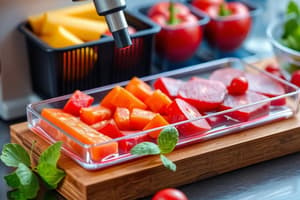Podcast
Questions and Answers
What does AOAC stand for?
What does AOAC stand for?
Analysis of Association of Official Agricultural Chemists
What is the primary purpose of instrument calibration in food analysis?
What is the primary purpose of instrument calibration in food analysis?
- To configure an instrument to provide acceptable results
- To eliminate factors causing inaccurate measurements
- To minimize factors causing imprecise measurements
- All of the above (correct)
Economy in food analysis refers to the costs involved in the analysis process.
Economy in food analysis refers to the costs involved in the analysis process.
True (A)
_______ is a measure of the internal friction of a liquid or its resistance to flow.
_______ is a measure of the internal friction of a liquid or its resistance to flow.
Match the following carbohydrate terms with their definitions:
Match the following carbohydrate terms with their definitions:
Flashcards are hidden until you start studying
Study Notes
Food Analysis
- Food analysis is the discipline that deals with the development, application, and study of analytical procedures for characterizing the properties of foods and their constituents.
- Quality control involves characterization of raw materials, monitoring of food properties during processing, and characterization of final product.
Organizations
- AOAC: Analysis of Association of Official Agricultural Chemists
- ISO: International Organization for Standardization
- IUPAC: International Union of Pure and Applied Chemistry
- IDF: International Dairy Federation
Instrument Calibration and Accuracy
- Instrument calibration is a primary process used to maintain instrument accuracy.
- Calibration: configuring an instrument to provide a result for a sample within an acceptable range.
- Eliminating or minimizing factors that cause inaccurate measurements is a fundamental aspect of instrumentation design.
- Precision: a measure of the ability to reproduce an answer between determinations performed by the same scientist or by different scientists in the same laboratory using the same procedure and instrument(s).
- Reproducibility: similar in principle to precision but based on the ability to reproduce an answer by different analysts and/or laboratories using the same procedures.
- Accuracy: expressed in terms of the ability to measure what is intended to be measured.
Performance Criteria for Analytical Methods
- Economy: expressed in terms of the costs involved in the analysis in terms of reagents, instrumentation, and time.
- Speed: based on the time to complete a particular analysis.
- Sensitivity: measured in terms of the capacity of the method to detect and quantify food constituents and/or contaminants at very low concentrations.
- Specificity: expressed in terms of the ability to detect and quantify specific food constituents even in the presence of similar compounds.
- Safety: many reagents used in food analysis are potentially hazardous; hazards include the corrosiveness of acids and the flammability of some organic solvents.
Sampling and Analysis
- Population: the whole of the material whose properties we are trying to obtain an estimate of.
- Sample: only a fraction of the population is usually selected for analysis.
- Laboratory Sample: the sample may be too large to conveniently analyze using a laboratory procedure and so only a fraction of it is actually used in the final laboratory analysis.
- Sampling Plans: developed to ensure that the estimated value obtained from the laboratory sample is a good representation of the true values of the population.
Rheological Properties
- Rheology: the science of deformation and flow of matter.
- Viscosity: an important property of fluid foods, defined as the internal friction of a liquid or its ability to resist flow.
- Dynamic viscosity: the internal friction of a liquid or its tendency to resist flow.
- Kinematic viscosity: defined as the absolute viscosity divided by the density of the fluid.
- Relative viscosity: sometimes called the ‘viscosity ratio,’ which is the ratio of the viscosity of a solution to the viscosity of the pure solvent.
- Apparent viscosity: the viscosity of non-Newtonian fluids expressed as though it were a Newtonian fluid.
Texture and Consistency
- Texture: the attribute resulting from a combination of physical properties perceived by the senses of kinesthesis, touch (including mouth, feel, sight, and hearing).
- Consistency: all the sensations resulting from stimulation of the mechanical receptors and tactile receptors, especially in the region of the mouth, and varying with the texture of the product.
- Hardness: a texture characteristic, describes a product which displays substantial resistance to deformation or breaking.
- Softness: a product which displays slight resistance to deformation.
- Tenderness: describes a product which, during mastication, displays little resistance to breaking.
- Firmness: describes a product which, during mastication, displays moderate resistance to breaking.
Studying That Suits You
Use AI to generate personalized quizzes and flashcards to suit your learning preferences.




